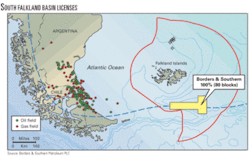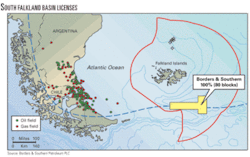Borders & Southern Petroleum PLC has identified three key play fairways and two prioritized prospects from initial review of 1,492 sq km of 3D seismic survey shot in 2008 on its Falkland Islands acreage.
The survey, which covered less than 8% of the company’s licensed area, led to identification of a seismic amplitude-supported Lower Cretaceous play fairway, an Upper Cretaceous-Lower Tertiary structural play fairway, and a Tertiary seismic amplitude-supported play fairway. Multiple prospects have been generated in the fairways.
The company said, “The 3D has revealed plenty of evidence for hydrocarbon generation and migration in the area. This includes a chain of five anticlines with gas hydrates located above the crests or slightly displaced on the asymmetric limb of the folds. Additionally, there are many seismic amplitude anomalies throughout the survey area.”
Borders & Southern is operator with 100% interest in six licenses in the South Falkland basin in the South Atlantic Ocean 150 km southeast of the islands. The frontier licenses are in 200 to 3,000 m of water.
Lower Cretaceous fairway
The Lower Cretaceous play fairway comprises sandstone reservoirs in tilted fault blocks and submarine fans.
The prospects are enhanced by seismic amplitude anomalies that display a strong AVO response that could be indicative of hydrocarbons.
“Our prioritized prospect within this play fairway is the Darwin prospect,” the company said. “In detail, it comprises two separate tilted fault blocks which may be joined as one large accumulation. This prospect is located updip of a regional migration pathway to a large source kitchen. Downdip of the prospect location, the source rock is modeled to be currently sitting in the oil generation window, and therefore oil is the most likely hydrocarbon phase to be encountered.”
The prospect is structurally robust, partly fault and dip closed. A strong AVO anomaly is associated with the target reservoir that clearly switches off at the bounding faults and at a closing contour on the dipping surface.
The total measured area for the AVO anomalies is 26 sq km. Potential P50 recoverable volumes estimated for the area defined by these AVO anomalies alone are 300 million bbl. However, if the accumulation extends down to the mapped closing contour then the accumulation would be significantly larger.
This prospect also has potentially deeper reservoir targets that fall within structural closure, leading to the possibility of stacked reservoirs.
Structural play fairway
The Upper Cretaceous-Lower Tertiary structural play fairway comprises sandstone reservoirs in major structural closures measuring up to 150 sq km.
The company’s prioritized prospect in this play fairway is the Stebbing prospect with 85 sq km of structural closure. The structure is a simple fold with four-way dip closure with a thrust located in its core.
A well-developed gas hydrate lies above the crest of the fold a few hundred meters below the seabed. Potential P50 recoverable reserves for the Upper Cretaceous-Lower Tertiary reservoir are 570 million bbl of oil.
Additional recoverable volumes related to the possibility of stacked reservoirs occur deeper within the structure. If this play fairway is successful, there are numerous robust structural closures within the portfolio that could deliver very large volumes of hydrocarbons, Borders & Southern said.
Tertiary play fairway
The Tertiary seismic amplitude-supported play fairway comprises Tertiary deepwater distributary sandstone reservoirs partly stratigraphically trapped in structural closures.
The play is marked by strong seismic AVO anomalies that could be indicative of hydrocarbons. The play extends over several structural culminations including the Stebbing prospect.
Potential P50 recoverable volumes estimated for the Tertiary reservoirs in the Stebbing structure are 710 million bbl of oil.
Prioritized prospects
Borders & Southern said the Darwin prospect has been prioritized due to its robust structure, its location at a migration focus in the basin, and the strong AVO support.
There are good analogs for this prospect in the Magallanes basin a few hundred kilometres to the west, where reported recoveries are about 6 billion bbl of oil equivalent.
The Stebbing prospect is prioritized due to the ability to test two separate play fairways, strong AVO anomalies at one reservoir level, and the presence of a gas hydrate above the structure.
The Darwin and Stebbing prospects are assessed as having the best chance of success and will be progressed to drill-ready status. Other than sharing the same source rock, they are completely independent, allowing different-aged rocks and different trapping configurations to be tested.
While these two prospects are currently the preferred first tests, the prospect inventory now has significant depth and with additional work alternative prospects may be high-graded, Borders & Southern said.
If success is achieved during the initial drilling program, there is plenty of scope for developing the prospect inventory outside the current 3D area. The mapped play fairways extend outside of the survey area and leads have already been identified.
With the initial interpretation phase completed, it is the directors’ intention to seek partners to help finance drilling. This effort will start in the first quarter of 2009.



